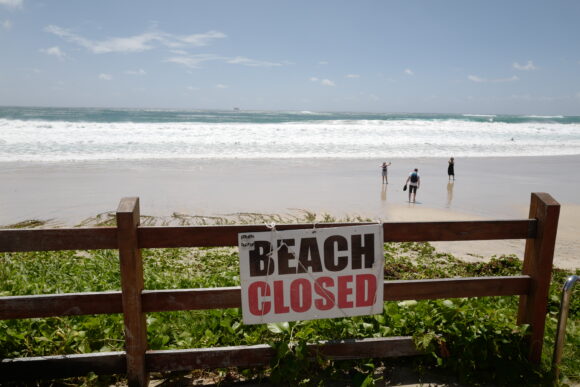Millions of Australians are bracing for a direct hit from a tropical cyclone heading toward the nation’s third-biggest city, with the storm already forcing evacuations and closing ports and schools throughout Queensland.
Tropical Cyclone Alfred, a category 2 cyclone, was 425 kilometers (264 miles) east of Brisbane at around 6 a.m. local time Wednesday, producing sustained winds of 95 kilometers an hour with gusts of up to 130 kilometers an hour, according to the national weather bureau.
It is forecast to maintain its intensity and cross the coast early Friday, somewhere between tourism hubs the Sunshine Coast and Gold Coast, and most likely near Brisbane.
Australia’s Insured Losses From Cyclone Alfred Could Top US$1.3 Billion: S&P
Alfred is set to be the first tropical storm to affect flood-prone Brisbane since 2017, when the remnants of Cyclone Debbie brought heavy rain and strong winds to the area after wreaking havoc in north Queensland. The city has a population of more than 2.5 million and millions more live in the forecast track or could be impacted by flooding.
Queensland Premier David Crisafulli told reporters Wednesday a small number of people had already been evacuated from their homes. “We’re telling Queenslanders that this is a serious event and it will cross the coast,” he said.
Rain Dump
Beyond any immediate damage from a direct cyclone hit, residents of the regions are bracing for the storm to dump massive amounts of rain that could flood homes and threaten lives. Southern Queensland and northern New South Wales could get rainfall totals of up to 400 millimeters (16 inches) over the next few days, with some places getting as much as 700 millimeters. The slow-moving storm also means its damaging winds and heavy rains will be sustained over a relatively long period of time.
Insurers Suncorp Group Ltd. and Insurance Australia Group Ltd. will be hard hit by losses caused by Alfred, according to Matt Ingram, senior industry analyst at Bloomberg Intelligence. In a Tuesday filing providing an update on the cyclone, Suncorp said it “maintains a strong capital position.”
Federal Minister for Emergency Management Jenny McAllister said the government expected the insurance sector will act quickly to aid customers affected by storm damage and the subsequent flooding that’s expected in some areas.
There was “still an element of the population that hasn’t yet fully understood the magnitude of this system,” McAllister told reporters late Tuesday. “We are in for some difficult days.”
Ports Shut
The Port of Brisbane suspended arrivals of large vessels on Sunday and expects to be closed on Thursday and Friday, and the city has suspended ferry services. Airports in the region were operating Tuesday, although airlines including Qantas Airways Ltd. and Virgin Australia Holdings Ltd. have offered rebooking options to passengers.
The storm is also expected to impact regions of New South Wales, to the south of Queensland. More than 120 schools have already been closed in that state, and evacuation centers opened.
Potentially damaging winds are already affecting the coast, with Byron Bay in New South Wales being hit by gusts of more than 100 kilometers an hour.
“There’s going to be damaging winds, there is going to be powerful surf, coastal erosion, and it will be followed by significant rain that can last a couple of days,” New South Wales State Emergency Services’ deputy commissioner Deb Platts said in a television interview.
Prime Minister Anthony Albanese flew into Brisbane on Tuesday evening. There’s been speculation the center-left leader would use this weekend to call an election for April 12, but such a scenario may be unlikely if the cyclone wreaks major damage.
“We’re governing,” Albanese told reporters when asked about the election speculation. “I know there’s others who are interested in election timing. What I’m interested in is getting things done on behalf of the country.”
Rare Cyclone
Modeling was showing almost 20,000 properties across Brisbane alone could be impacted by storm surges or flooding, the city’s Lord Mayor Adrian Schrinner said in a post on X.
Scientific research indicates that as global temperatures climb, tropical cyclones will shift more toward the poles, posing extreme weather threats to places that were not designed to withstand such hazards.
Southern Queensland and northern NSW are regions that face growing risk from tropical cyclones, according to Climate Risk Group. That will likely drive up insurance premiums for property owners, the firm said in a statement.
“We don’t often have tropical cyclone watches and warnings in the New South Wales jurisdiction — the most recent one was back in 1990 with an event called Tropical Cyclone Nancy,” the Bureau of Meteorology’s Steve Bernasconi said on Monday. “And prior to that, it wasn’t until 1974 with Tropical Cyclone Zoe.”
Photograph: A beach-closed sign beside Main Beach caused by Cyclone Alfred on March 04, 2025 in Byron Bay, Australia. Photo credit: James D. Morgan/Getty Images AsiaPac
Related:
Topics Australia
Was this article valuable?
Here are more articles you may enjoy.



 Delta Plane Catches Fire at Orlando Airport in Latest Incident for Airline
Delta Plane Catches Fire at Orlando Airport in Latest Incident for Airline  Pet Insurance, Agents Gets a Shorter Leash Under Bill DeSantis Signed Into Law
Pet Insurance, Agents Gets a Shorter Leash Under Bill DeSantis Signed Into Law  Group Sues California Department of Insurance Over FAIR Plan Surcharges
Group Sues California Department of Insurance Over FAIR Plan Surcharges  Wildfire Losses Drop Chubb Q1 Net Income 38%, While Tariffs Create ‘Confusion’
Wildfire Losses Drop Chubb Q1 Net Income 38%, While Tariffs Create ‘Confusion’ 

